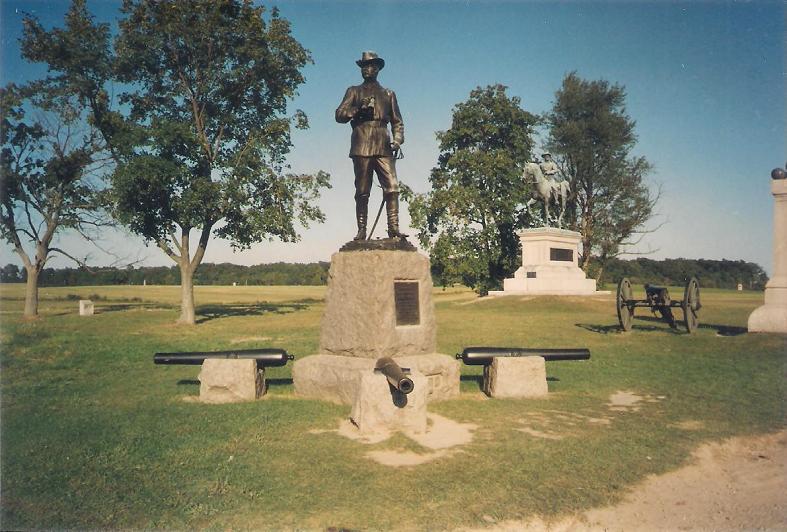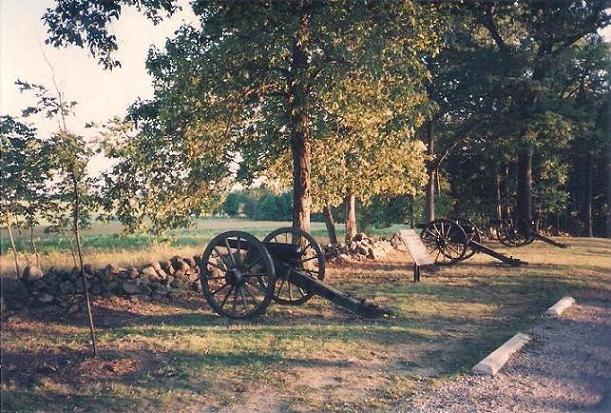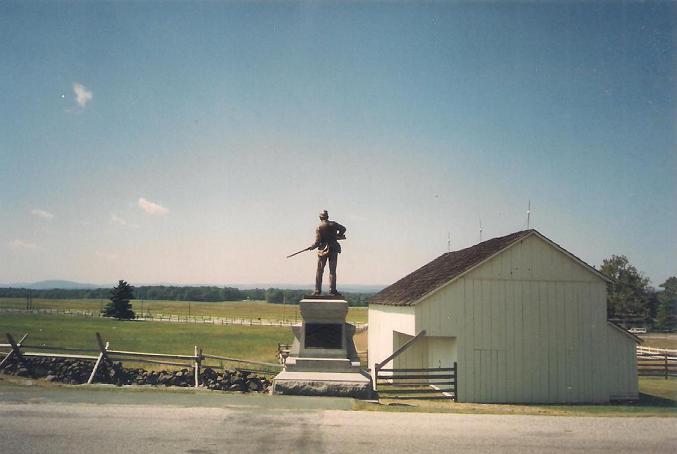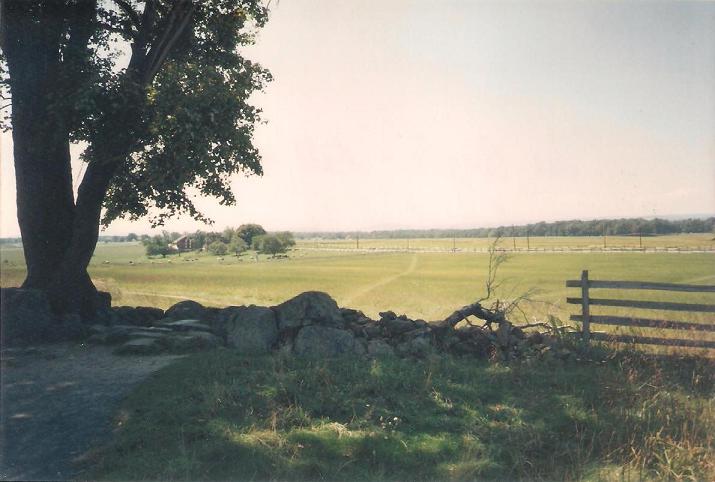![The Mohican Board! [Bumppo's Redux!] The Mohican Board! [Bumppo's Redux!]](images/wwwboard.gif) |
|
| Author |
 Topic Topic  |
|
|
James N.
Colonial Militia
   

USA

Bumppo's Patron since [at least]:
October 24 2007
Status: offline
|
 Posted - June 30 2013 : 1:50:10 PM Posted - June 30 2013 : 1:50:10 PM



|
Of course tomorrow, July 1, marks the Sesquicentennial of the great battle of 1863. I have been very active lately on the forum CivilWarTalk creating posts similar to those here on F&I and Revolutionary topics. Here are a few photos I recently scanned relating to the battle:
Image Insert:

83.85 KB
The Battle of Gettysburg began here on McPherson Ridge the morning of July, 1, 1863, when a Confederate brigade of Gen. Henry Heth's Division attempted to push aside Union cavalry commanded by Gen. John Buford. His statue, and that of Union I Corps commander Gen. John F. Reynolds, who was killed nearby, are above; the cannon at the base of Buford's statue pointing towards the camera is the very one that fired the first artillery round of the battle.
Image Insert:

82.83 KB
Union artillery battery north of Gettysburg. The defeat of the XI Corps here late in the afternoon of July 1 caused the collapse of the entire Union battleline. The Federals retreated in some confusion to the heights of Cemetery Hill; below, the gatehouse to the town cemetery, later that November the scene of President Lincoln's Gettysburg Address.
Image Insert:

59.05 KB
Image Insert:

54.39 KB
On the second day of the battle fighting began late, as Gen. R. E. Lee shifted fresh troops into attck positions. Fresh Union troops had also arrived in the night. Gen. Dan Sickles Union III Corps imprudently advanced into the path of Lee's intended attack at Sherfy's Peach Orchard, above.
Image Insert:

83.51 KB
A weird geologic formation known locally as Devil's Den became a confused battlefield as Union defenders were driven from the pile of huge boulders by Confederates of Gen. John Hood's Division. Attacking Confederates proceeded from here through what became known as The Valley of Death.
Image Insert:

45.68 KB
The best-known action of the battle's second day occurred here in the struggle for the high ground known as Little Round Top. Originally unoccuppied, the Union army's chief engineer, Gen. Gouverneur K. Warren, whose statue is above, saw Hood's approaching Confederates and rushed troops of the V Corps here, including the 20th Maine of Col. Joshua Chamberlain.
Image Insert:

81.06 KB
Position markers like this dot the battlefield today; this one is for Chamberlain's 20th Maine on the Union army's far left flank in the woods on Little Round Top near the center of their stand against Col. William Oates attacking 15th Alabama. Here and all along the hilltop position the defenders prevailed against the attacking Confederates.
Image Insert:

87.17 KB
As the struggle for Little Round Top hung in the balance, all along the line of Sickle's III Corps Gen. James Longstreet's attacking Confederates gained ground. An especially contested spot was a large Wheatfield that eventually drew in parts of the Union II, III, and V Corps and Confederates from Hood's Division and that of Lafayette McLaws. Above is the monument to another of the famous units that fought here, the Union's Irish Brigade, with its Celtic cross and Irish wolfhound.
Image Insert:

74.85 KB
The collapse of the Peach Orchard Salient and subsequent Union retreat to Cemetery Ridge in the twilight brought an end to the battle on this flank. Confederate attacks at dusk on the opposite flank at Culp's Hill and Cemetery Hill were repulsed. The Union commander, Gen. George Meade, made his headquarters near the center of his army in the tiny farmhouse at left above. That night a council of war agreed to remain on the battlefield and await Lee's next move.
Image Insert:

82.12 KB
Next morning, July 3, 1863, the battle reached its climax, as Lee decided on a grand assault on Meade's center on Cemetery Ridge. Prior to the attack, beginning after noon Lee's artillery shelled the Union position from batteries like this along opposing Seminary Ridge in the largest artillery duel ever seen on this continent.
Image Insert:

33.04 KB[size=1]
Spearheaded by the fresh division of Virginians led by Gen. George Pickett, Lee's attack probably numbered around 12,000 men. Unfortunately, over half of those, under Gen. Isacc Trimble and Gen. Johnson Pettigrew, were the shot-up divisions that had fought on July 1. Once the guns fell silent, Pickett's men began their mile-long advance across the open fields bordering the Emmitsburg Road above, as Union defenders watched and waited.
Image Insert:

[size=1] 50.87 KB
When they reached the fence along the road, union artillery opened on them with great effect; even worse, however, was the storm of rifle fire as they got even closer to their objective, a small "clump of trees". Here at the Angle of a low stone wall behind which the Federals waited, a mere hanful of Confederates, led by brigade commander Gen. Lewis Armistead, pierced the lines, but were quickly shot down or captured. The rest had already become casualties or turned back to their own lines. Despite some simultaneous cavalry actions on both flanks, the failure of "Pickett's Charge" effectively ended the Battle of Gettysburg. Lee began his retreat back to Virginia the following night, July 4, 1863.
|
|
report to moderator
|
|
|
richfed
Sachem
    
     

USA

Bumppo's Patron since [at least]:
May 13 2002
Status: offline
Administrator |
 Posted - July 01 2013 : 12:56:01 PM Posted - July 01 2013 : 12:56:01 PM





|
| As always, great post and photos, James! Thank you!! |
report to moderator  |
|
|
Monadnock Guide
Council of Elders
    
   
USA

Bumppo's Patron since [at least]:
March 14 2005
Status: offline
|
 Posted - July 01 2013 : 1:52:36 PM Posted - July 01 2013 : 1:52:36 PM



|
| I'll second that - the pics & narrative are always top drawer, .... |
you can keep "The Change" |
report to moderator  |
|
|
Monadnock Guide
Council of Elders
    
   
USA

Bumppo's Patron since [at least]:
March 14 2005
Status: offline
|
 Posted - July 02 2013 : 07:53:52 AM Posted - July 02 2013 : 07:53:52 AM



|
Another side often overlooked, ...
.
http://www.accuweather.com/en/features/trend/battle_of_gettysburg_150th_ann/14824506
.
Some wounded soldiers had still not been moved from low-lying areas by the Plum Run Creek, however, which overflowed its banks. Those stranded near the flood waters, reportedly all Confederates, drowned.
.
"They had to move a 17-mile-long train of wagons filled with wounded soldiers over the dissolving dirt roads back to Virginia," he said. "And the rains caused the Potomac River--easily fordable on the march north--to flow so high that the army was trapped on the north side with the Union forces in pursuit. The Confederates dug in for a desperate battle, but in the end were able to escape across the river on the 13th, the day before Meade's planned attack." |
you can keep "The Change" |
report to moderator  |
|
|
Monadnock Guide
Council of Elders
    
   
USA

Bumppo's Patron since [at least]:
March 14 2005
Status: offline
|
 Posted - July 05 2013 : 06:14:22 AM Posted - July 05 2013 : 06:14:22 AM



|
http://www.foxnews.com/us/2013/07/04/gettysburg-hero-may-get-medal-honor-150-years-later/
.
Two Wisconsin congressmen successfully added an amendment to the annual defense bill that would pave the way for the Medal of Honor to be awarded to a Union artillery officer credited for his heroism at Gettysburg 150 years ago.
First Lt. Alonzo H. Cushing positioned his unit on Gettysburg’s Cemetery Ridge and endured multiple injuries during the historic Pickett's Charge, Hope Landsem, a second class cadet at the U.S. Military Academy, wrote in the Wall Street Journal. |
you can keep "The Change" |
report to moderator  |
|
|
IWLFNDU
Colonial Settler
  

USA
Bumppo's Patron since [at least]:
May 08 2010
Status: offline
|
 Posted - July 21 2013 : 7:03:27 PM Posted - July 21 2013 : 7:03:27 PM



|
quote:
Originally posted by Monadnock Guide
Another side often overlooked, ...
.
http://www.accuweather.com/en/features/trend/battle_of_gettysburg_150th_ann/14824506
.
Some wounded soldiers had still not been moved from low-lying areas by the Plum Run Creek, however, which overflowed its banks. Those stranded near the flood waters, reportedly all Confederates, drowned.
.
"They had to move a 17-mile-long train of wagons filled with wounded soldiers over the dissolving dirt roads back to Virginia," he said. "And the rains caused the Potomac River--easily fordable on the march north--to flow so high that the army was trapped on the north side with the Union forces in pursuit. The Confederates dug in for a desperate battle, but in the end were able to escape across the river on the 13th, the day before Meade's planned attack."
Did not know that, MG. Wow....
|
''Only when the last tree has died, the last river has been poisoned, and the last fish has been caught, will we realize that we cannot eat money.''
~ Cree Proverb |
report to moderator  |
|
| |
 Topic Topic  |
|
|
|
| The Mohican Board! [Bumppo's Redux!] |
© 1997-2025 - Mohican Press |
 |
|
| Current Mohicanland page raised in 0.32 seconds |
 |
|

![The Mohican Board! [Bumppo's Redux!] The Mohican Board! [Bumppo's Redux!]](images/wwwboard.gif)


